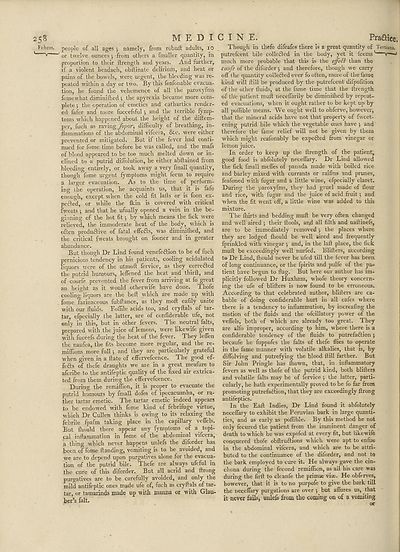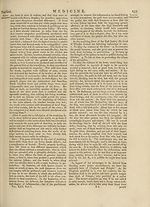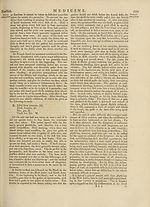Encyclopaedia Britannica, or, a Dictionary of arts, sciences, and miscellaneous literature : enlarged and improved. Illustrated with nearly six hundred engravings > Volume 13, MAT-MIC
(300) Page 258
Download files
Complete book:
Individual page:
Thumbnail gallery: Grid view | List view

MEDICINE.
people of all ages ; namely, from robuft adults, 10
or twelve ounces j 'from others a fmaller quantity, m
proportion to their ftrength and years. And further,
If a violent headach, obllinate delirium, and heat or
pains of the bowels, were urgent, the bleeding was re¬
peated within a day or two. By this feafonable evacua¬
tion, he found the vehemence of all the paroxyfms
fomewhat diminifhed •, the apyrexia became more com¬
plete } the operation of emetics and cathartics render¬
ed fafer and more fuccefsful and the terrible fymp-
toms which happened about the height of the diftem-
per, fucli as raving fopor, difficulty of breathing, in¬
flammations of the abdominal vifcera, &c. were either
prevented or mitigated. But if the fever had conti¬
nued for fome time before he was called, and the mafs
of blood appeared to be too much melted down or in¬
clined to a putrid dhTolution, he either abftained from
bleeding entirely, or took away a very fmall quantity,
though fome urgent fymptoms might feem to require
a larger evacuation. As to the time of perform¬
ing the operation, he acquaints us, that it is fafe
enough, except when the cold fit lafts or is foon ex-
pc61ed, or while the fkin is covered with critical
fweats ; and that he ufually opened a vein in the be¬
ginning of the hot fit *, by which means the fick were
relieved, the immoderate heat of the body, which is
often productive of fatal effefts, was diminilhed, and
the critical fweats brought on fooner and in greater
abundance.
But though Dr Lind found venefeftion to be of fuch
pernicious tendency in his patients, cooling acidulated
liquors were of the utmoft fervice, as they corre&ed
the putrid humours, leffened the heat and thiril, and
of courfe prevented the fever from arriving at fo great
an height as it would otherwife have done. Thofe
cooling liquors are the bell which are made up with
fome farinaceous fubftance, as they moft eafily unite
with our fluids. Foffile acids too, and cryftals of tar¬
tar, efpecially the latter, are of confiderable ufe, not
only in this, but in other fevers. I he neutral falls,
prepared with the juice of lemons, were likewife given
with fuceefs during the heat of the fever. They leffen
the naufea, the fits become more regular, and the re-
miflions more full ; and they are particularly grateful
Avhen given in a date of effervefcence. The good ef-
fefts of thefe draughts we are in a great meafure to
afcribe to the antifeptic quality of the fixed air extrica¬
ted from them, during the effervefcence.
During the remiflion, it is proper to evacuate the
putrid humours by fmall doles of ipecacuanha, or ra¬
ther tartar emetic. The tartar emetic indeed appears
to be endowed with fome kind of febrifuge ^ virtue,
which Dr Cullen thinks is owing to its relaxing the
febrile fpafm taking place in the capillary veffels.
But fliould there appear any fymploms. of a topi¬
cal inflammation in fome of the abdominal vifcera,
a thing which never happens unlefs the diforder has
been of fome ftanding, vomiting is to be avoided, and
we are to depend upon purgatives alone for the evacua¬
tion of the putrid bile. Thefe are always ufeful in
the cure of this diforder. But all acrid and ftrong
purgatives are to be carefully avoided, and only the
mild antifeptic ones made ufe of, fueh as cryftals of tar¬
tar, or tamarinds made up with manna or with Glau¬
ber’s fait.
Pra&ice,
Though in thefc difeafes there is a great quantity of Tertiana.
putrefcent bile collected in the body, yet it leemsk|"” v '-J
much more probable that this is the ejfeSi than the
cau/e of the diforder; and therefore, though we carry
off the quantity collected ever fo often, more of the fame
kind will ftill be produced by the putrefcent difpofition
of the other tluids, at the fame time that the ftrength
of the patient muft neceffarily be dhniniihed by repeat¬
ed evacuations, when it ought rather to be kept up by
all poffible means. We ought well to obferve, however,
that the mineral acids have not that property of fweet-
ening putrid bile which the vegetable ones have j and
therefore the fame relief will not be given by them
which might reafonably be expected from vinegar or
lemon juice.
In order to keep up the ftrength of the patient,
good food is abfolutely neceffary. Dr Lind allowed
the fick fmall meffes of panada made with boiled rice
and barley mixed with currants or raifins and prunes,
fealoned with fugar and a little wine, efpecially claret.
During the paroxyfms, they had gruel made of flour
and rice, with fugar and the juice of acid fruit ; and
when the fit went off, a little wine was added to this
mixture.
The Hurts and bedding muft be very often changed
and well aired ; their ftools, and all filth and naftinefs,
are to be immediately removed j the places where
they are lodged fhould be well aired and frequently
fprinkled with vinegar •, and, in the laft place, the fick
muff be exceedingly well nurfed. Blifters, according
t® Dr Lind, fhould never be ufed till the fever has been
of long continuance, or the fpirits and pulfe of the pa¬
tient have begun to flag. But here our author has im¬
plicitly followed Dr Huxham, whofe theory concern¬
ing the ufe of blifters is now found to be erroneous.
According to that celebrated author, blifters are ca-
bable of doing confiderable hurt in all cafes where
there is a tendency to inflammation, by increafing the
motion of the fluids and the ofcillatory power of the
veffels, both of which are already too great. They
are alfo improper, according to him, where there is a
confiderable tendency of the fluids to putrefaftion j
becaufe he fuppofes the falts of thefe flies to operate
in the fame manner with volatile alkalies, that is, by
diffolving and putrefying the blood ftill farther. But
Sir John Pringle has Ihown, that, in inflammatory
fevers as wTell as thofe of the putrid kind, both blifters
and volatile falts may be of fervice j the latter, parti¬
cularly, he hath experimentally proved to be fo far from
promoting putrefaction, that they are exceedingly ftrong
antifeptics.
In the Eaft Indies, Dr Lind found it abfolutely
neeeffary to exhibit the Peruvian bark in large quanti¬
ties, and as early as poflible. By this method he not
only fecured the patient from the imminent danger of
death to which he was expofed at every fit, but likewife
conquered thofe obftruCtions which were apt to enfue
in the abdominal vifcera, and which are to be attri¬
buted to the continuance of the diforder, and not to
the bark employed to cure it. He always gave the cin¬
chona during the fecond remiflion, as all his care was
during the firft to clcanfe the primse vise. He obferves,
however, that it is to no purpofe to give the bark till
the neceffary purgations are over j but affures us, that
it never fails, unleL from the coming on of a vomiting
or
people of all ages ; namely, from robuft adults, 10
or twelve ounces j 'from others a fmaller quantity, m
proportion to their ftrength and years. And further,
If a violent headach, obllinate delirium, and heat or
pains of the bowels, were urgent, the bleeding was re¬
peated within a day or two. By this feafonable evacua¬
tion, he found the vehemence of all the paroxyfms
fomewhat diminifhed •, the apyrexia became more com¬
plete } the operation of emetics and cathartics render¬
ed fafer and more fuccefsful and the terrible fymp-
toms which happened about the height of the diftem-
per, fucli as raving fopor, difficulty of breathing, in¬
flammations of the abdominal vifcera, &c. were either
prevented or mitigated. But if the fever had conti¬
nued for fome time before he was called, and the mafs
of blood appeared to be too much melted down or in¬
clined to a putrid dhTolution, he either abftained from
bleeding entirely, or took away a very fmall quantity,
though fome urgent fymptoms might feem to require
a larger evacuation. As to the time of perform¬
ing the operation, he acquaints us, that it is fafe
enough, except when the cold fit lafts or is foon ex-
pc61ed, or while the fkin is covered with critical
fweats ; and that he ufually opened a vein in the be¬
ginning of the hot fit *, by which means the fick were
relieved, the immoderate heat of the body, which is
often productive of fatal effefts, was diminilhed, and
the critical fweats brought on fooner and in greater
abundance.
But though Dr Lind found venefeftion to be of fuch
pernicious tendency in his patients, cooling acidulated
liquors were of the utmoft fervice, as they corre&ed
the putrid humours, leffened the heat and thiril, and
of courfe prevented the fever from arriving at fo great
an height as it would otherwife have done. Thofe
cooling liquors are the bell which are made up with
fome farinaceous fubftance, as they moft eafily unite
with our fluids. Foffile acids too, and cryftals of tar¬
tar, efpecially the latter, are of confiderable ufe, not
only in this, but in other fevers. I he neutral falls,
prepared with the juice of lemons, were likewife given
with fuceefs during the heat of the fever. They leffen
the naufea, the fits become more regular, and the re-
miflions more full ; and they are particularly grateful
Avhen given in a date of effervefcence. The good ef-
fefts of thefe draughts we are in a great meafure to
afcribe to the antifeptic quality of the fixed air extrica¬
ted from them, during the effervefcence.
During the remiflion, it is proper to evacuate the
putrid humours by fmall doles of ipecacuanha, or ra¬
ther tartar emetic. The tartar emetic indeed appears
to be endowed with fome kind of febrifuge ^ virtue,
which Dr Cullen thinks is owing to its relaxing the
febrile fpafm taking place in the capillary veffels.
But fliould there appear any fymploms. of a topi¬
cal inflammation in fome of the abdominal vifcera,
a thing which never happens unlefs the diforder has
been of fome ftanding, vomiting is to be avoided, and
we are to depend upon purgatives alone for the evacua¬
tion of the putrid bile. Thefe are always ufeful in
the cure of this diforder. But all acrid and ftrong
purgatives are to be carefully avoided, and only the
mild antifeptic ones made ufe of, fueh as cryftals of tar¬
tar, or tamarinds made up with manna or with Glau¬
ber’s fait.
Pra&ice,
Though in thefc difeafes there is a great quantity of Tertiana.
putrefcent bile collected in the body, yet it leemsk|"” v '-J
much more probable that this is the ejfeSi than the
cau/e of the diforder; and therefore, though we carry
off the quantity collected ever fo often, more of the fame
kind will ftill be produced by the putrefcent difpofition
of the other tluids, at the fame time that the ftrength
of the patient muft neceffarily be dhniniihed by repeat¬
ed evacuations, when it ought rather to be kept up by
all poffible means. We ought well to obferve, however,
that the mineral acids have not that property of fweet-
ening putrid bile which the vegetable ones have j and
therefore the fame relief will not be given by them
which might reafonably be expected from vinegar or
lemon juice.
In order to keep up the ftrength of the patient,
good food is abfolutely neceffary. Dr Lind allowed
the fick fmall meffes of panada made with boiled rice
and barley mixed with currants or raifins and prunes,
fealoned with fugar and a little wine, efpecially claret.
During the paroxyfms, they had gruel made of flour
and rice, with fugar and the juice of acid fruit ; and
when the fit went off, a little wine was added to this
mixture.
The Hurts and bedding muft be very often changed
and well aired ; their ftools, and all filth and naftinefs,
are to be immediately removed j the places where
they are lodged fhould be well aired and frequently
fprinkled with vinegar •, and, in the laft place, the fick
muff be exceedingly well nurfed. Blifters, according
t® Dr Lind, fhould never be ufed till the fever has been
of long continuance, or the fpirits and pulfe of the pa¬
tient have begun to flag. But here our author has im¬
plicitly followed Dr Huxham, whofe theory concern¬
ing the ufe of blifters is now found to be erroneous.
According to that celebrated author, blifters are ca-
bable of doing confiderable hurt in all cafes where
there is a tendency to inflammation, by increafing the
motion of the fluids and the ofcillatory power of the
veffels, both of which are already too great. They
are alfo improper, according to him, where there is a
confiderable tendency of the fluids to putrefaftion j
becaufe he fuppofes the falts of thefe flies to operate
in the fame manner with volatile alkalies, that is, by
diffolving and putrefying the blood ftill farther. But
Sir John Pringle has Ihown, that, in inflammatory
fevers as wTell as thofe of the putrid kind, both blifters
and volatile falts may be of fervice j the latter, parti¬
cularly, he hath experimentally proved to be fo far from
promoting putrefaction, that they are exceedingly ftrong
antifeptics.
In the Eaft Indies, Dr Lind found it abfolutely
neeeffary to exhibit the Peruvian bark in large quanti¬
ties, and as early as poflible. By this method he not
only fecured the patient from the imminent danger of
death to which he was expofed at every fit, but likewife
conquered thofe obftruCtions which were apt to enfue
in the abdominal vifcera, and which are to be attri¬
buted to the continuance of the diforder, and not to
the bark employed to cure it. He always gave the cin¬
chona during the fecond remiflion, as all his care was
during the firft to clcanfe the primse vise. He obferves,
however, that it is to no purpofe to give the bark till
the neceffary purgations are over j but affures us, that
it never fails, unleL from the coming on of a vomiting
or
Set display mode to:
![]() Universal Viewer |
Universal Viewer | ![]() Mirador |
Large image | Transcription
Mirador |
Large image | Transcription
Images and transcriptions on this page, including medium image downloads, may be used under the Creative Commons Attribution 4.0 International Licence unless otherwise stated. ![]()
| Permanent URL | https://digital.nls.uk/192665062 |
|---|
| Attribution and copyright: |
|
|---|
| Description | Ten editions of 'Encyclopaedia Britannica', issued from 1768-1903, in 231 volumes. Originally issued in 100 weekly parts (3 volumes) between 1768 and 1771 by publishers: Colin Macfarquhar and Andrew Bell (Edinburgh); editor: William Smellie: engraver: Andrew Bell. Expanded editions in the 19th century featured more volumes and contributions from leading experts in their fields. Managed and published in Edinburgh up to the 9th edition (25 volumes, from 1875-1889); the 10th edition (1902-1903) re-issued the 9th edition, with 11 supplementary volumes. |
|---|---|
| Additional NLS resources: |
|

